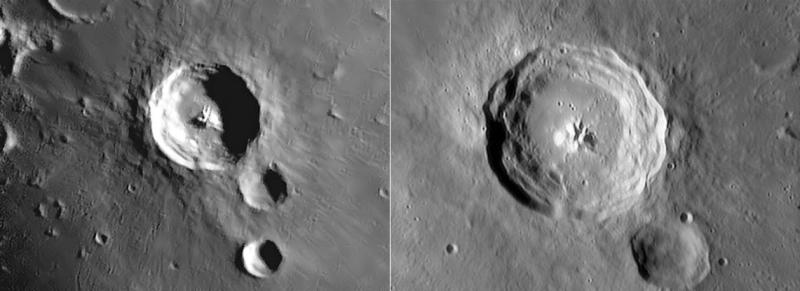Here are two good images of Bullialdus - which is best? Its pretty clear that the resolution of the right image - taken with the 24" Ludiver telescope is excellent - perhaps 800 meters! Small craters are cleanly visible on the floor and outer ramparts - these could be counted to estimate Bullialdus' age in billions of years. And the image shows where wall terraces still stand and where they have collapsed toward the floor...and are the smooth parts of the floor impact melts or lava flows - good question! This is a great picture, Bruno - thanks! The photo to the left was acquired under lower lighting and covers a wider area. The relationships of the crater ejecta and the mare are well documented. In most places Bullialdus secondary craters and ejecta striations are clearly depicted cutting into the mare. But on the NW side of the crater the lava is smooth and uncut by ejecta. Bullialdus presents no evidence of being an oblique impact so its ejecta must have once been there. We have to conclude that the patch of lava NW of Bullialdus is younger than the crater. This is a nice deduction of stratigraphic history allowed by this image's combination of wide view, good resolution and low lighting (showing where secondaries are and aren't). This is a great picture, John - thanks!
Related Links:
Sussenbach's Digital Astroimaging site
Technical Details:
Left image (Sussenbach) 11 April 2003. C11, 2X Barlow and Toucam Pro
Right image (Daversin) Ludiver Planetarium and Observatory: 24" cassegrain, f/D=16.
|
Yanvar' Fevral' Mart Aprel' Mai Iyun' Iyul' Avgust Sentyabr' Oktyabr' Noyabr' Dekabr' |
|
Publikacii s klyuchevymi slovami:
Moon - Luna - Lunar Photo of the Day - LPOD
Publikacii so slovami: Moon - Luna - Lunar Photo of the Day - LPOD | |
Sm. takzhe:
Vse publikacii na tu zhe temu >> | |
